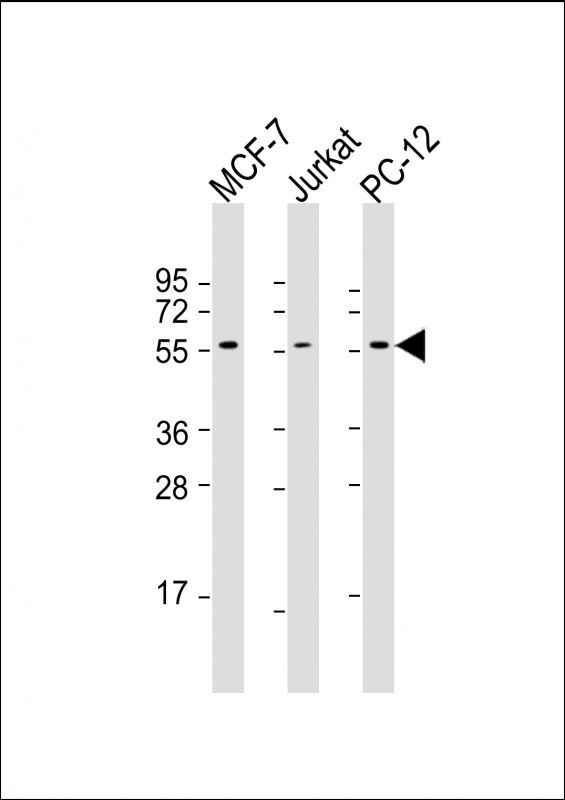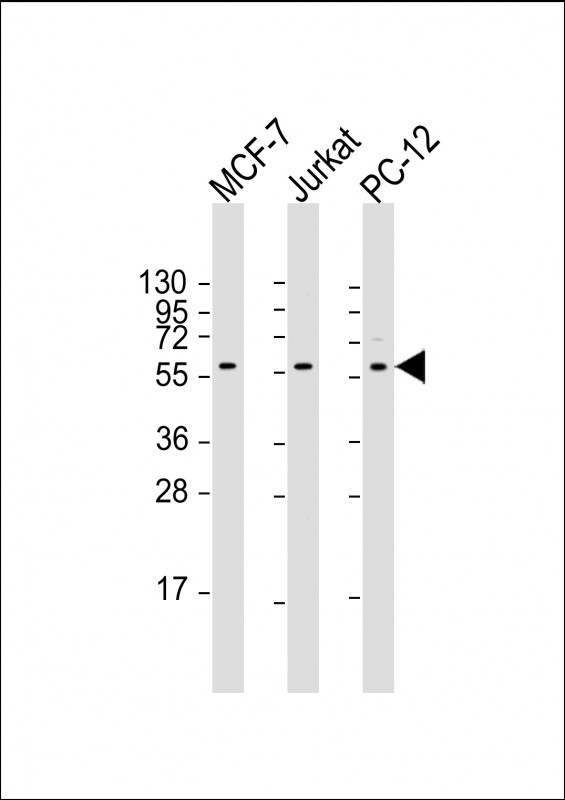Mouse anti-AKT2 Monoclonal Antibody(1623CT791.157.67.66)描述别名宿主特异性反应种属应用分子量类型克隆号同种型储存/保存方法研究领域背景说明细胞定位UniProt参考文献
| 概述 | |
| 描述 |
Purified Mouse Monoclonal Antibody (Mab)
|
| 别名 |
AKT2抗体;RAC-beta serine/threonine-protein kinase; 2.7.11.1; Protein kinase Akt-2; Protein kinase B beta; PKB beta; RAC-PK-beta; AKT2
|
| 宿主 |
Mouse
|
| 特异性 |
This AKT2 antibody is generated from a mouse immunized with a recombinant protein between 272-481amino acids from human AKT2.
|
| 反应种属 |
Human, Rat
|
| 应用 |
IF~~1:25
WB~~1:2000 |
| 分子量 |
Predicted molecular weight: 56kD
Disclaimer note: The observed molecular weight of the protein may vary from the listed predicted molecular weight due to post translational modifications, post translation cleavages, relative charges, and other experimental factors. |
| 性能 | |
| 类型 |
Monoclonal Antibody
|
| 克隆号 |
1623CT791.157.67.66
|
| 同种型 |
IgG1
|
| 储存/保存方法 |
Maintain refrigerated at 2-8°C for up to 2 weeks. For long term storage store at -20°C in small aliquots to prevent freeze-thaw cycles.
|
| 研究领域 |
Cancer;Cardiovascular;Cell Biology;Immunology;Metabolism;Neuroscience;Signal Transduction;Stem Cells
|
| 靶标 | |
| 背景说明 |
AKT2 is one of 3 closely related serine/threonine- protein kinases (AKT1, AKT2 and AKT3) called the AKT kinase, and which regulate many processes including metabolism, proliferation, cell survival, growth and angiogenesis. This is mediated through serine and/or threonine phosphorylation of a range of downstream substrates. Over 100 substrate candidates have been reported so far, but for most of them, no isoform specificity has been reported. AKT is responsible of the regulation of glucose uptake by mediating insulin-induced translocation of the SLC2A4/GLUT4 glucose transporter to the cell surface. Phosphorylation of PTPN1 at ‘Ser-50’ negatively modulates its phosphatase activity preventing dephosphorylation of the insulin receptor and the attenuation of insulin signaling. Phosphorylation of TBC1D4 triggers the binding of this effector to inhibitory 14-3-3 proteins, which is required for insulin-stimulated glucose transport. AKT regulates also the storage of glucose in the form of glycogen by phosphorylating GSK3A at ‘Ser-21’ and GSK3B at ‘Ser-9’, resulting in inhibition of its kinase activity. Phosphorylation of GSK3 isoforms by AKT is also thought to be one mechanism by which cell proliferation is driven. AKT regulates also cell survival via the phosphorylation of MAP3K5 (apoptosis signal-related kinase). Phosphorylation of ‘Ser-83’ decreases MAP3K5 kinase activity stimulated by oxidative stress and thereby prevents apoptosis. AKT mediates insulin-stimulated protein synthesis by phosphorylating TSC2 at ‘Ser-939’ and ‘Thr-1462’, thereby activating mTORC1 signaling and leading to both phosphorylation of 4E-BP1 and in activation of RPS6KB1. AKT is involved in the phosphorylation of members of the FOXO factors (Forkhead family of transcription factors), leading to binding of 14-3-3 proteins and cytoplasmic localization. In particular, FOXO1 is phosphorylated at ‘Thr-24’, ‘Ser-256’ and ‘Ser-319’. FOXO3 and FOXO4 are phosphorylated on equivalent sites. AKT has an important role in the regulation of NF-kappa-B-dependent gene transcription and positively regulates the activity of CREB1 (cyclic AMP (cAMP)- response element binding protein). The phosphorylation of CREB1 induces the binding of accessory proteins that are necessary for the transcription of pro-survival genes such as BCL2 and MCL1. AKT phosphorylates ‘Ser-454’ on ATP citrate lyase (ACLY), thereby potentially regulating ACLY activity and fatty acid synthesis. Activates the 3B isoform of cyclic nucleotide phosphodiesterase (PDE3B) via phosphorylation of ‘Ser-273’, resulting in reduced cyclic AMP levels and inhibition of lipolysis. Phosphorylates PIKFYVE on ‘Ser-318’, which results in increased PI(3)P-5 activity. The Rho GTPase-activating protein DLC1 is another substrate and its phosphorylation is implicated in the regulation cell proliferation and cell growth. AKT plays a role as key modulator of the AKT-mTOR signaling pathway controlling the tempo of the process of newborn neurons integration during adult neurogenesis, including correct neuron positioning, dendritic development and synapse formation. Signals downstream of phosphatidylinositol 3-kinase (PI(3)K) to mediate the effects of various growth factors such as platelet-derived growth factor (PDGF), epidermal growth factor (EGF), insulin and insulin-like growth factor I (IGF-I). AKT mediates the antiapoptotic effects of IGF-I. Essential for the SPATA13-mediated regulation of cell migration and adhesion assembly and disassembly. May be involved in the regulation of the placental development.
|
| 细胞定位 |
Cytoplasm. Nucleus. Cell membrane; Peripheral membrane protein. Note=Localizes within both nucleus and cytoplasm of proliferative primary myoblasts and mostly within the nucleus of differentiated primary myoblasts. By virtue of the N-terminal PH domain, is recruited to sites of the plasma membrane containing increased PI(3,4,5)P3 or PI(3,4)P2, cell membrane targeting is also facilitared by interaction with CLIP3
|
| UniProt |
P31751
|
| 参考文献 | |
| 参考文献 |
Jones P.F.,et al.Cell Regul. 2:1001-1009(1991).
Cheng J.Q.,et al.Proc. Natl. Acad. Sci. U.S.A. 89:9267-9271(1992). Ota T.,et al.Nat. Genet. 36:40-45(2004). Grimwood J.,et al.Nature 428:529-535(2004). Walker K.S.,et al.Biochem. J. 331:299-308(1998). |
实验结果图

All lanes : Anti-AKT2 Antibody at 1:1000-1:2000 dilution Lane 1: MCF-7 whole cell lysate Lane 2: Jurkat whole cell lysate Lane 3: PC-12 whole cell lysate Lysates/proteins at 20 µg per lane. Secondary Goat Anti-mouse IgG, (H+L), Peroxidase conjugated at 1/10000 dilution. Predicted band size : 56 kDa Blocking/Dilution buffer: 5% NFDM/TBST.

All lanes : Anti-AKT2 Antibody at 1:2000 dilution Lane 1: MCF-7 whole cell lysate Lane 2: Jurkat whole cell lysate Lane 3: PC-12 whole cell lysate Lysates/proteins at 20 µg per lane. Secondary Goat Anti-mouse IgG, (H+L), Peroxidase conjugated at 1/10000 dilution. Predicted band size : 56 kDa Blocking/Dilution buffer: 5% NFDM/TBST.
